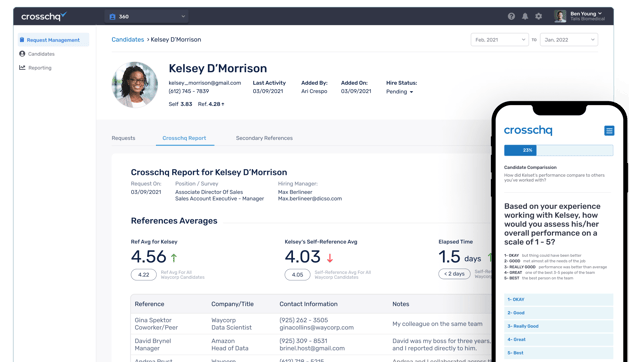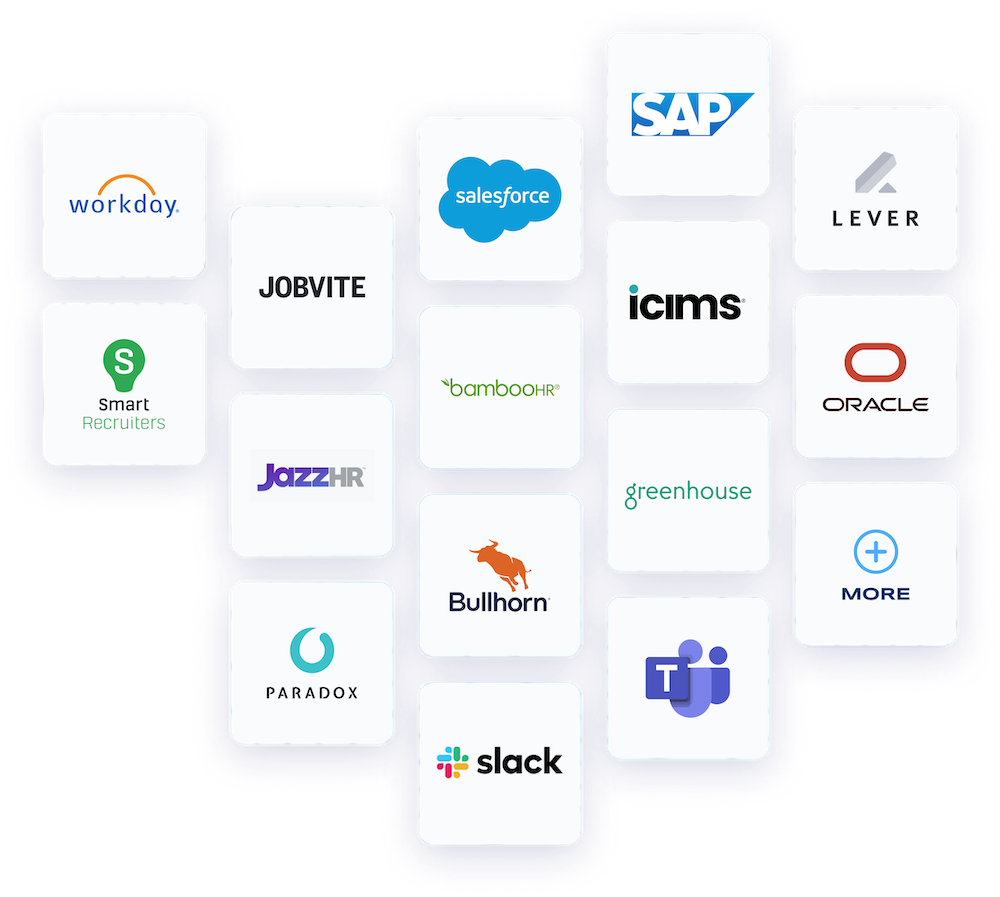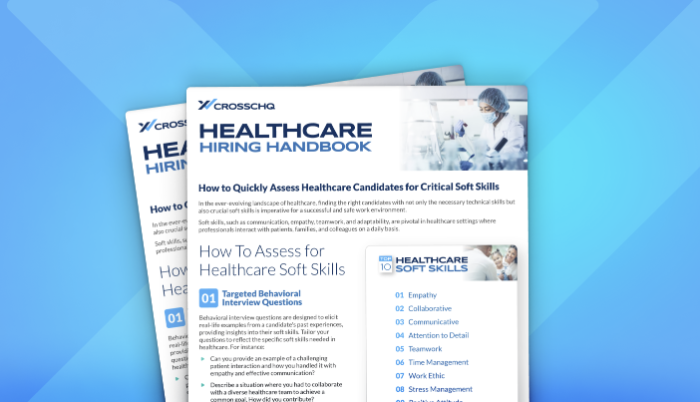

Crosschq Blog
5 Ways To Know If You Are Hiring A Toxic Employee

Companies are responsible for providing a work environment where each employee can grow, learn, and thrive. But one wrong choice during the candidate selection process can disrupt the effort, cause enormous loss, and affect the whole workplace.
What is a toxic employee?
Toxic employees are typically self-centered, charismatic, confident, and put themselves first. These individuals continuously say I much more than WE. However, problematic employees also tend to play the victim card and blame others for their behaviors.
What are the signs of a toxic employee?
Typically, with toxic employees, there are a number of signs to look for. These include:
- A negative attitude
- Unwillingness to help others
- Unwillingness to take responsibility
- Gossip about co-workers, managers, clients, or customers
- Sabotage their work or the work of others
- Insubordination and a lack of following direction
- Unprofessional and inappropriate communications
- Bullying and harassing coworkers
The cost of a toxic employee
A study by Harvard Business School showed that high-performers, known as superstar employees, can generate 80 percent of a business’s profits. It's no wonder recruiting efforts focus primarily on hiring more superstars. However, another group affects companies even more intensely: toxic employees.
In fact, that same study found that avoiding a toxic hire can save an organization more than twice as much as hiring a top-performing employee. The cost of employing individuals with harmful attitudes or behavior issues add up quickly and even go beyond the financial aspect.
Here is everything you should know about toxic employee traits, how to spot the warning signs, and how to avoid hiring these individuals. Use these guidelines to identify toxic employees to protect your company.
How do toxic employees affect business and co-workers?
Simply because of the sheer volume of recruiting at many organizations, hiring a toxic employee is an unfortunate but inevitable scenario. That said, there are steps you can take to identify and avoid these individuals. To start, let's review the common characteristics of a negative-impact employee.
According to SHRM, a "bad" employee engages in behavior that’s harmful to an organization, its property, or people. Toxic employee traits that you might expect include overconfidence, a self-centered or -serving attitude. However, toxic employees also hold some unexpected traits, including mid to high-level productivity, and an unexpected respect for following rules.
Due to these unforeseen somewhat positive traits, identifying a harmful employee can be challenging. These individuals often tend to obey their superiors and complete their tasks faster than their co-workers. They can be are high performers, charismatic, curious, and have high self-esteem.
But despite these beneficial characteristics, SHRM states that toxic employees are Machiavellian in nature and can hurt other workers’ performance and cause regulatory and legal fees. They can instill distrust, kill team productivity, alienate their co-workers, and lower employee morale, affecting a company’s bottom line and work environment.
As an HR professional, you can avoid workplace toxicity by identifying potentially toxic candidates early and hire only the most compatible employees.
Here is how to spot toxic employees.
Crosschq can help you quickly identify signals of potentially toxic hires.
Use automated, digital reference checks to gather feedback from previous managers and coworkers and uncover potentially toxic employees. Read more about our 360 reference check solution here.
How to manage toxic employees?
It can be incredibly difficult to deal with, let alone manage toxic employees and behaviors in the workplace. Oftentimes, the best way to manage toxic employees is to approach the situation with sensitivity, empathy, and care. Below are some steps that you can take to initiate a conversation with employees that are displaying toxic behavior.
- Approach your employee with care and have a conversation in private to discuss their toxic behavior and how it is impacting the team and work environment.
- Prepare for pushback. No one wants to hear negative feedback. Make sure to approach the conversation with empathy and try to understand why they have displayed toxic behavior in the workplace.
- Make sure to have the conversation documented and have a record of all complaints from fellow team members.
- Provide your employee with constructive feedback both in private and public. Set them up to succeed by offering actionable steps that they can take to improve.
- Understand the situation and grow as a manager. Approach the situation as a learning experience for both you and your employee. Learn where you may have fallen short as a manager for them and if there was anything you could have done differently to help them.
5 ways to identify warning signs of a toxic employee
Traditionally, the best way to spot signs of a toxic employee has been during the interview. If you, ask the right questions you may be able to identify individuals who could damage your business and work environment before you hire them.
1. TOXICITY-TRIGGERING QUESTIONS
If you want to identify whether you’re dealing with potentially problematic future employees, ask questions that can reveal their attitudes and behavior. Candidates who have nothing nice to say about their previous (or current) employer are a big red flag.
Ask what they liked least about their former workplace, manager, or supervisors. If the job applicant has a list of things they disliked, especially targeting someone’s personality, dive deeper into the topic with additional clarifying questions.
Moreover, if you discover that they hold grudges against their previous employers, consider whether they sound objective, self-centered, or irrational.
2. ASK HOW THEY HANDLED CHALLENGING SITUATIONS
People often show their true colors during a conflict. When pressure enters the picture, some employees become aggressive while others often play the victim. Both of these are toxic employee traits.
Ask candidates about the most challenging situation they had to handle in their former workplace and how they solved it. Watch out for those candidates who always blame others and avoid taking responsibility for their actions.
Pay extra attention to those who say they can solve any issue without much struggle and who don’t give any credit to their team and co-workers.
3. PAY ATTENTION TO COMPLAINTS
Sometimes, you don’t even have to ask questions that could trigger candidates to speak about their previous employers. They will do it themselves. These candidates tend to find reasons to mention their former workplace and portray it negatively whenever possible.
Although each employee will dislike something about their job role or even workplace, if complaints are the overwhelming majority, that’s concerning.
On the other side, job applicants full of praises for themselves are also a red flag. If you encounter a self-centered individual who appears to be exaggerating their accomplishments, that could also be a sign of toxicity.
4. EXTENSIVE INTERVIEW PROCESS
Interviews are usually too short when aiming to uncover the true nature of candidates. It is why you should consider setting up multiple stages of selection to get to know your prospective employees.
Consider implementing short case studies, personality tests, and surveys to understand who your candidates are. Use these to identify whether their skills, attitudes, and experiences are compatible with the company and whether they fit into the workplace culture.
5. CONDUCT REFERENCE CHECKS
Get more insights and confirm the data you received from references.
Even though references might not report anything openly disheartening, see if they have anything that reveals there could be more to the story. If more than one reference says something that indicates toxicity symptoms, you should be highly careful with the candidate.
Crosschq will help you quickly identify toxic employees.
Gathering feedback from previous managers and coworkers can actually be the best and fastest way to uncover potentially toxic hires. Traditional checks over the phone may not elicit much information, but upgrading to automated, digital reference checks make it easy and fast. Check out our 360 reference check solution for more information.
In-depth selection process for identifying toxic employees
Toxic employees account for three to five percent of all workforce, but their behavior impacts their colleagues and company culture more intensely than superstar employees. Incivility can affect the workplace and your business just as much as sexual harassment, bullying, and theft, causing revenue loss, employee turnover, and killing productivity.
Use the interview to identify the signs of a toxic employee before hiring them. Implement additional stages to the hiring process, such as case studies, personality tests, and surveys to detect potentially detrimental traits.
Watch out for self-centered individuals, complaints about the former employers, and the victim attitude. If you recognize toxicity before hiring the candidate, you could save the company from losing high-performing employees, revenues, and reputation.
Avoid hiring toxic employees and start building better teams by choosing Crosschq, the Human Intelligence Hiring™ platform with automated digital reference checks and talent analytics. Request your demo here!
Toxic Employee FAQ
1. How do toxic employees affect the workplace?
These employees cause revenue loss, affect team productivity, and often force high-performing employees to quit due to being subjected to incivility.
2. Are toxic employees necessarily low performers?
Despite their negative traits, these employees are usually high performers individually. They tend to complete their tasks first and with excellent results. However, toxic employees covertly subject their co-workers to incivility, causing a decline in overall team productivity or increased absenteeism.
3. How can recruiters prevent hiring toxic employees?
HR professionals can establish an in-depth selection process that includes personality tests, surveys, and case studies to understand the candidates better. Recruiters can also ask toxicity-triggering questions to identify signs of a toxic employee.
5. How does Crosschq help to identify toxic employees?
Crosschq uses a cloud-based, data-driven digital reference checking and talent analytics platform powered by Human Intelligence Hiring that helps recruiters get in-depth insights into candidates and employ the most compatible employee.
Learn how Crosschq helps organizations make better hires through automated digital reference checks, pipeline efficiency and talent analytics. Get a demo!
Newsletter Sign Up

by Lucas Sonini
Contributing Writer
File Under
Take the Guesswork
Out of Hiring
Schedule a demo now



%20-200x43.png)






